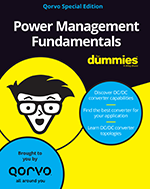Power Up Your Power Management Knowledge
April 20, 2021
While power management plays a critical role in almost all electronic devices, it’s often not a huge focus. The power management system improves product reliability, increases performance, and often handles a wide range of other functions. Power management integrated circuits (PMICs) are especially important in battery-powered electronic devices, including smartphones and wearables, because of their small size, high efficiency, and design flexibility.
Our newly developed Power Management Fundamentals For Dummies book explains power management basics and the latest trends and applications. Here are some highlights from the e-book:
1. DC Battery Configurations
The type of power management subsystem that an electronic device uses depends on its power source. These sources can include AC, DC, or ultra-low-power DC sources such as solar power. Many of our devices get their DC power from individual batteries or battery packs containing multiple batteries. These batteries can be arranged in various ways to provide different current and voltage outputs. For example:
- Arranging batteries in series increases a battery pack’s peak voltage and increases its capacity.
- Arranging batteries in parallel doesn’t increase the voltage, but it does increase the overall current capability and capacity of the battery pack.
- Configuring batteries in series and in parallel increases voltage, current, and capacity simultaneously.

2. Types of DC Voltage Regulators
In some battery-powered applications, the system components may not be able to directly use the battery’s power, so DC-DC converters are used to monitor and stabilize the voltage delivered to the system. These converters are also called voltage regulators because they regulate and adjust the supplied voltage. Voltage regulators are classified into two main categories, depending on the voltage conversion method they use.
- Linear regulators convert an input voltage (Vin) to a different voltage output (Vout) using a linear (resistive) component to regulate Vout. They are typically used for lower power output applications. Linear regulators provide low noise output, so they are suitable for sensitive analog components such as sensors. One drawback is that they are not very efficient.
- In contrast, switching regulators are efficient, flexible, and small, but they emit high-frequency noise. Switching regulators use Field Effect Transistors (FET) to transform the DC input voltage into an AC waveform, which is then converted back to DC at a different output voltage using capacitors and inductors.
3. Switching Regulators
Switching regulators are classified according to the relationship between their input and output voltage.
- Buck switching regulator: Vout is less than Vin.
- Boost switching regulator: Vout is greater than Vin.
- Buck-boost switching regulator: Vout is variable: it could be lower, higher, or the same as Vin.
The diagram below compares the four commonly used regulator topologies: Low-Drop linear regulators (LDOs) and the three switching regulators – buck, boost, and buck-boost.

4. Today’s Power Management Integrated Circuits (PMICs)
PMICs are small, versatile integrated circuits used for voltage conversion, voltage regulation, and battery management. Today’s PMICs can handle several or even all the application voltage regulation functions needed within an electronic device. They can be adapted for different applications by simply changing the firmware or register settings, eliminating the need for costly hardware changes. This helps bring new applications in applications faster at a lower cost.

PMICs are used across many different industries and product categories. They can perform a wide variety of functions, including intelligent motor control and power protection as well as DC-DC conversion and regulation. Because of their tiny size and low power consumption, PMICs are used in many small devices such as wearables, “hearables” such as earbuds, mobile devices, sensors, and Internet of Things (IoT) devices. They maximize product performance and efficiency, increase design flexibility, and reduce bill-of-materials cost, helping manufacturers reduce overall cost and accelerate time-to-market.
The above is just a brief excerpt from the newly released Power Management Fundamentals For Dummies from Qorvo. We encourage you to download our free e-book for more insights into power management.
Have another topic that you would like Qorvo experts to cover? Email your suggestions to the Qorvo Blog team and it could be featured in an upcoming post. Please include your contact information in the body of the email.

